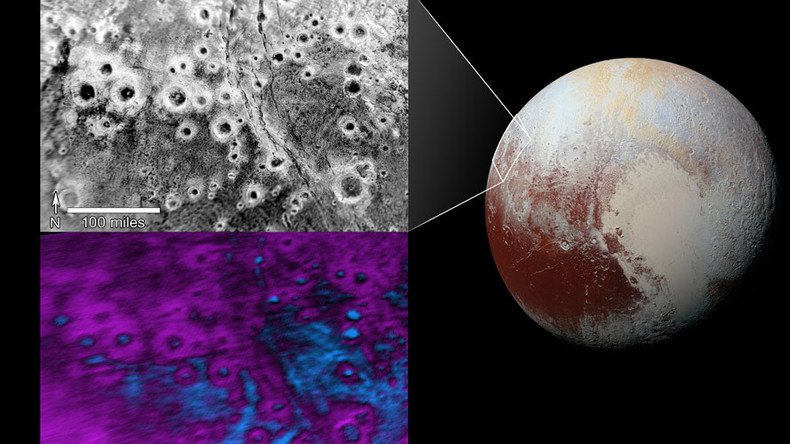Cluster of bright “halo” craters spotted on Pluto (PHOTO)

An image captured by a NASA spacecraft reveals a region of eye catching craters on the surface of Pluto that resembles a cluster of bright halos scattered across a dark background.
The stunning photo of the dwarf planet’s “Vega Terra” region was taken by NASA’s New Horizons spacecraft as it made a close approach last summer.
Dwarf planet reveals a little more: NASA snaps stunning images of bright craters https://t.co/hM3PzVDGgThttps://t.co/eLUtag5sC2
— RT America (@RT_America) April 20, 2016
Researchers believe it is likely that the “bright halos” are caused by methane ice covering the craters’ walls and rims.
READ MORE:Giant ‘icy spider’ captured on Pluto’s surface in latest NASA image (PHOTO)
This is highlighted in the lower image by composition data from New Horizons’ Ralph/Linear Etalon Imaging Spectral Array (LEISA), represented in purple. The floors and terrain between the craters show signs of water ice, which are highlighted in blue.
Craters on Pluto look like a cluster of bright halos scattered across a dark landscape: https://t.co/4EnjZhfIpTpic.twitter.com/eFSKTYqapH
— NASA (@NASA) April 21, 2016
Scientists don’t know why the bright methane ice settles on these crater rims and walls, however. Why this same effect doesn’t occur all across Pluto is also an enigma.
The craters are rather considerable in size. The largest, which can be seen in the bottom right area of the upper image, measures about 30 miles (50 kilometers) in diameter.
The images were taken on July 14 last year.











